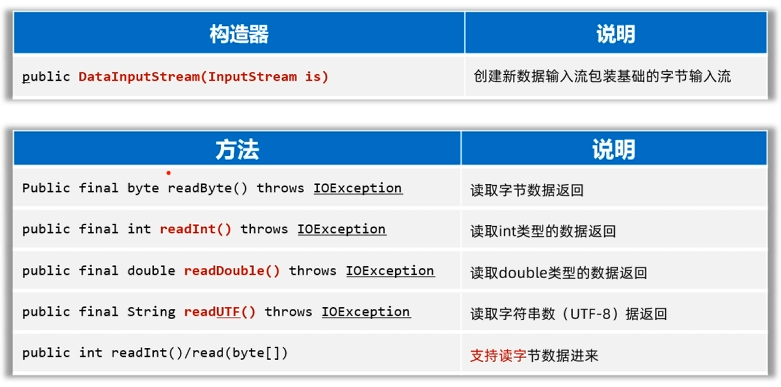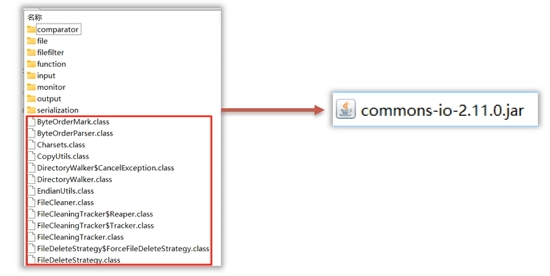IO流-字符流
FileReader(文件字符输入流)
- 作用:以内存为基准,可以把文件中的数据以字符的形式读入到内存中去。
![image]()
案例:读取一个字符
//目标:文件字符输入流的使用,每次读取一个字符。
public class FileReaderDemo01 {public static void main(String[] args){//1. 创建字符输入流管道与源文件接通try(Reader reader = new FileReader("day10-io-code\\src\\chartest.txt");){//2. 读取一个字符,返回编号,没有字符可读时返回-1。int c;while((c = reader.read()) != -1) {char ch = (char) c;System.out.print(ch);}}catch(Exception e){e.printStackTrace();}//拓展:解决了乱码的问题,2.性能较差。}
}
案例:读取多个字符
//目标:文件字符输入流的使用:每次读取多个字符
public class FileReaderDemo02 {public static void main(String[] args) {//1. 创建字符输入流管道与源文件接通try(Reader reader = new FileReader("day10-io-code\\src\\chartest.txt");){//2. 定义一个字符数组char[] buf = new char[3];int len;while((len = reader.read(buf)) != -1) {String str = new String(buf, 0, len);System.out.print(str);}}catch(Exception e){e.printStackTrace();}//拓展:解决了乱码的问题,2.性能挺好。这是目前来说学到过的读取文本文件的最好的方式。}
}
FileWriter(文件字符输出流)
- 作用:以内存为基准,把内存中的数据以字符的形式写出到文件中去。
![image]()
案例
//目标:文件字符输出流的使用
public class FileReaderDemo03 {public static void main(String[] args) {//1. 创建字符输出流管道与源文件接通try(//Writer rt = new FileWriter("day10-io-code\\src\\chartest1.txt");//覆盖管道Writer rt = new FileWriter("day10-io-code\\src\\chartest1.txt", true);//追加管道){//2. 写一个字符出去rt.write(98);rt.write("\r\n");rt.write('王');rt.write("我是中国人,我爱我的祖国!",3 ,6);rt.write("\r\n");// //3. 刷新
// rt.flush();}catch(Exception e){e.printStackTrace();}}
}
字符输出流使用的注意事项
- 字符输出流写出数据后,必须刷新流,或者关闭流,写出去的数据才能生效。
![image]()
字节流、字符流的使用场景小结:
- 字节流适合做一切文件数据的拷贝(音视频、文本);字节流不适合读取中文内容输出。
- 字符流适合做文本文件的操作(读、写)。
IO流-缓冲流
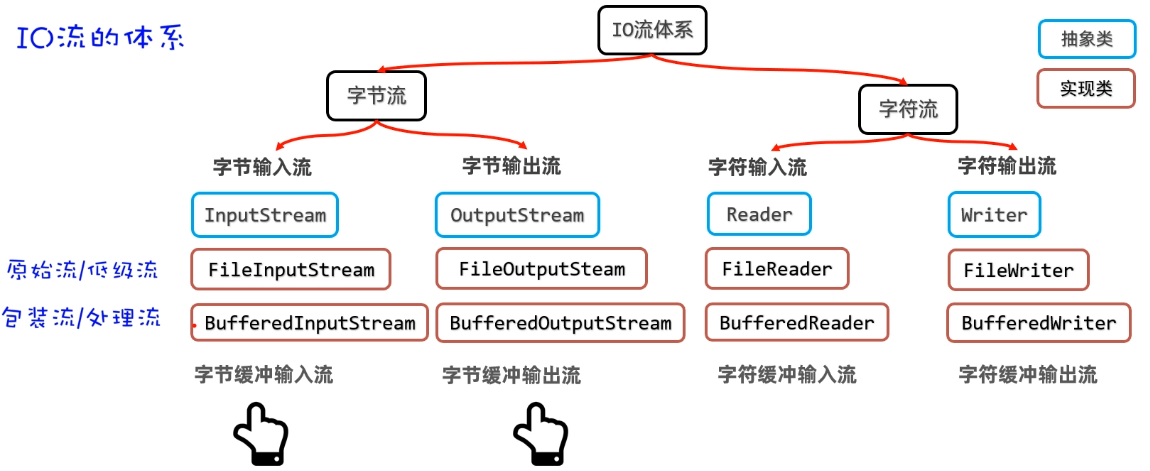
字节缓冲流的作用
- 提高字节流读写数据的性能。
- 原理:字节缓冲输入流自带了8KB缓冲池;字节缓冲输出流也自带了8KB缓冲池。
![image]()
案例
//目标:使用字节缓冲流提升原始字节流读写数据的性能。
public class BufferedInputStreamDemo01 {public static void main(String[] args) {//1. 创建字节流输入流管道与源文件接通try(InputStream in = new FileInputStream("F:\\360安全浏览器下载\\4b60c2c15cad30091caa0940e15fadb4.jpeg");//2. 使用高级的缓冲流包装低级的字节输入流InputStream bin = new BufferedInputStream(in);OutputStream out = new FileOutputStream("F:\\360安全浏览器下载\\4b60c2c15cad30091caa0940e15fadb4_bak.jpeg");//3. 使用高级的缓冲流包装低级的字节输出流OutputStream bout = new BufferedOutputStream(out);){//准备一个字节数组byte[] buf = new byte[1024];int len;while((len = bin.read(buf)) != -1){bout.write(buf, 0, len);}}catch (IOException e) {throw new RuntimeException(e);}}
}
字符缓冲输入流(BufferReader)
- 作用:自带8K(8192)的字符缓冲池,可以提高字符输入流读取字符数据的性能。
![image]()
字符缓冲输入流新增的功能:按照行读取字符

案例
public class BufferedReaderDemo01 {public static void main(String[] args) {//1. 创建字符输入流管道与源文件接通try(Reader fr = new FileReader("day10-io-code\\src\\chartest2.txt");// 把低级的字符输入流包装成一个高级的缓冲字符输入流BufferedReader fr2 = new BufferedReader(fr);){//2. 定义一个字符数组用于读取多个字符/* char[] buf = new char[1024];int len;while((len = fr2.read(buf)) != -1){String rs = new String(buf, 0, len);System.out.print(rs);}*///3. 缓冲字符输入流多了一个按照行读取内容的方式功能。String ln;while((ln = fr2.readLine()) != null){System.out.println(ln);}}catch (IOException e){e.printStackTrace();}}
}
字符缓冲输出流(BufferedWriter)
- 作用:自带8K的字符缓冲池,可以提高字符输出流写字符数据的性能。
![image]()
字符缓冲输出流新增的功能:换行

案例
//目标:掌握缓冲字符流的使用
public class BufferedWirterDemo02 {public static void main(String[] args) {try(//1. 创建一个文件字符输出流管道与源文件接通FileWriter fw = new FileWriter("day10-io-code\\src\\chartest2.txt");BufferedWriter br = new BufferedWriter(fw);){//2. 写一个字符出去br.write(98);br.write('c');br.newLine();br.write("我是中国人,我爱我的祖国!");br.newLine();}catch(Exception e){e.printStackTrace();}}
}
案例:原始流、缓冲流的性能分析
测试用例:
- 分别使用原始的字节流,以及字节缓冲流复制一个很大视频。
测试步骤:
- 使用低级的字节流按照一个一个字节的形式复制文件。
- 使用低级的字节流按照字节数组的形式复制文件。
- 使用高级的缓冲字节流按照一个一个字节的形式复制文件。
- 使用高级的缓冲字节流按照字节数组的形式复制文件。
//目标:原始流和缓冲流的性能分析
//1. 使用低级的字节流按照一个一个字节的形式复制文件。
//2. 使用低级的字节流按照字节数组的形式复制文件。
//3. 使用高级的缓冲字节流按照一个一个字节的形式复制文件。
//4. 使用高级的缓冲字节流按照字节数组的形式复制文件。
public class TimeTest05 {public static final String SRC_VIDEO = "F:\\BaiduNetdiskDownload\\0412 天才的学习方法\\0412 天才的学习方法.mp4";public static final String DEST_VIDEO = "D:\\WEMedia\\";public static void main(String[] args) {
// copy01(); //使用低级的字节流按照一个一个字节的形式复制文件:速度非常慢,禁止使用,直接淘汰!copy02(); //使用低级的字节流按照字节数组的形式复制文件:速度还可以,相对来说比较慢。
// copy03(); //使用高级的缓冲字节流按照一个一个字节的形式复制文件:特别慢,不推荐使用。copy04(); //使用高级的缓冲字节流按照字节数组的形式复制文件:极快,推荐使用!}public static void copy01(){long start = System.currentTimeMillis();//1. 使用低级的字节流按照一个一个字节的形式复制文件。try (//1. 创建字节流输入流管道与源文件接通InputStream in = new FileInputStream(SRC_VIDEO);//2. 创建字节输出流管道与目标文件接通OutputStream out = new FileOutputStream(DEST_VIDEO + "01.mp4");) {int len;while ((len = in.read()) != -1) {out.write(len);}long end = System.currentTimeMillis();System.out.println("1.使用低级的字节流总耗时:" + (end - start) / 1000.0 + "s");} catch (Exception e) {e.printStackTrace();}}public static void copy02(){long start = System.currentTimeMillis();//2. 使用低级的字节流按照字节数组的形式复制文件。try (//1. 创建字节流输入流管道与源文件接通InputStream in = new FileInputStream(SRC_VIDEO);//2. 创建字节输出流管道与目标文件接通OutputStream out = new FileOutputStream(DEST_VIDEO + "02.mp4");) {byte[] buf = new byte[1024];int len;while ((len = in.read(buf)) != -1) {out.write(len);}long end = System.currentTimeMillis();System.out.println("2.使用低级的字节流按照字符数组的形式,总耗时:" + (end - start) / 1000.0 + "s");} catch (Exception e) {e.printStackTrace();}}public static void copy03(){long start = System.currentTimeMillis();//3. 使用高级的缓冲字节流按照一个一个字节的形式复制文件。try (//1. 创建字节流输入流管道与源文件接通InputStream in = new FileInputStream(SRC_VIDEO);InputStream bin = new BufferedInputStream(in);//2. 创建字节输出流管道与目标文件接通OutputStream out = new FileOutputStream(DEST_VIDEO + "03.mp4");OutputStream bout = new BufferedOutputStream(out);) {int len;while ((len = bin.read()) != -1) {bout.write(len);}long end = System.currentTimeMillis();System.out.println("3.使用高级的缓冲字节流总耗时:" + (end - start) / 1000.0 + "s");} catch (Exception e) {e.printStackTrace();}}public static void copy04(){long start = System.currentTimeMillis();//3. 使用高级的缓冲字节流按照一个一个字节的形式复制文件。try (//1. 创建字节流输入流管道与源文件接通InputStream in = new FileInputStream(SRC_VIDEO);InputStream bin = new BufferedInputStream(in);//2. 创建字节输出流管道与目标文件接通OutputStream out = new FileOutputStream(DEST_VIDEO + "04.mp4");OutputStream bout = new BufferedOutputStream(out);) {byte[] buf = new byte[1024];int len;while ((len = bin.read(buf)) != -1) {bout.write(len);}long end = System.currentTimeMillis();System.out.println("3.使用高级的缓冲字节流总耗时:" + (end - start) / 1000.0 + "s");} catch (Exception e) {e.printStackTrace();}}
}
IO流-转换流
不同编码读取出现乱码的问题
- 如果代码编码和被读取的文本文件的编码是一致的,使用字符流读取文本文件时不会出现乱码!
- 如果代码编码和被读取的文本文件的编码是不一致的,使用字符流读取文本文件就会出现乱码!
字符输入转换流(InputStreamReader)
- 解决不同编码时,字符流读取文本内容乱码的问题。
- 解决思路:先获取文件的原始字节流,再将其按照真实的字符集编码转成字符输入流,这样字符输入流中的字符就不会乱码了。
![image]()
案例
//目标:字符输入转换流
public class Test01 {public static void main(String[] args) {try(//1. 得到GBK文件的原始字节输入流InputStream in = new FileInputStream("D:\\java_project\\resource\\ds.txt");//2. 通过字符输入转换流把原始字节流按照指定编码转换成字符输入流。Reader ir = new InputStreamReader(in, "GBK");//3. 把字符输入流包装成高级的缓冲字符输入流BufferedReader isr = new BufferedReader(ir);){//4. 按照行读取String ln ;while((ln = isr.readLine()) != null){System.out.println(ln);}} catch (Exception e) {e.printStackTrace();}}
}
字符输出转换流(OutputStreamWriter)
-
需要控制写出去的字符使用什么字符集编码该怎么办?
- 调用String提供的getBytes方法解决。
![image]()
- 使用“字符输出转换流”实现。
- 调用String提供的getBytes方法解决。
-
作用:可以控制写出去的字符使用什么字符集编码。
-
解决思路:获取字节输出流,在按照指定的字符集编码将其转换成字符输出流,以后写出去的字符就会用该字符集编码了。
![image]()
案例
//目标:掌握字符输出转换流的使用
public class Test02 {public static void main(String[] args) {try (//1.创建一个输出字节流于源文件连通OutputStream out = new FileOutputStream("D:\\java_project\\resource\\ds1.txt");//2.创建一个字符输出转换流,把字节输出流按照指定编码转换成字符输出流Writer ow = new OutputStreamWriter(out, "GBK");//3.把字符输出流包装成高级的缓冲字符输出流BufferedWriter bw = new BufferedWriter(ow);){bw.write("hello world!");bw.newLine();bw.write("我是中国人,我爱我的祖国!");bw.newLine();} catch (Exception e) {e.printStackTrace();}}
}
IO流-打印流
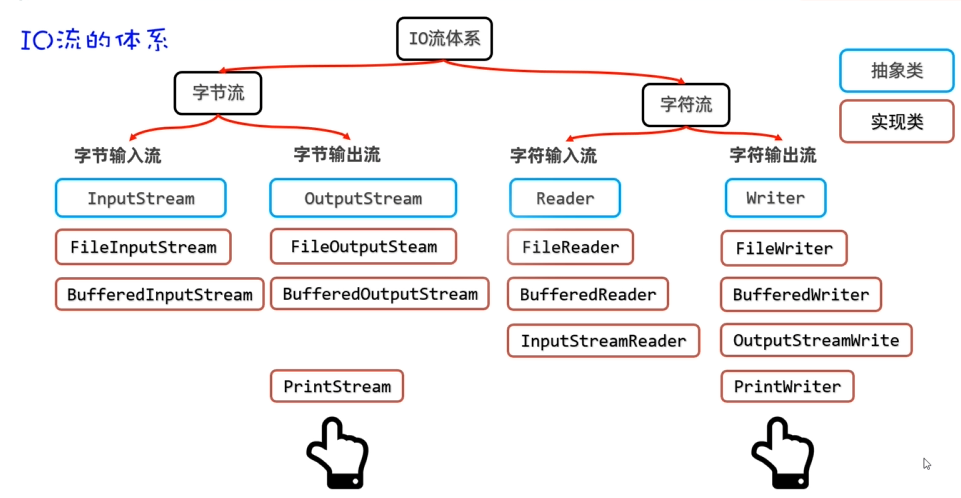
PrintStream/PrintWriter(打印流)
- 作用:打印流可以实现更方便、更高效的打印数据出去,能实现打印啥出去就是啥出去。
PrintStream提供的打印数据的方案
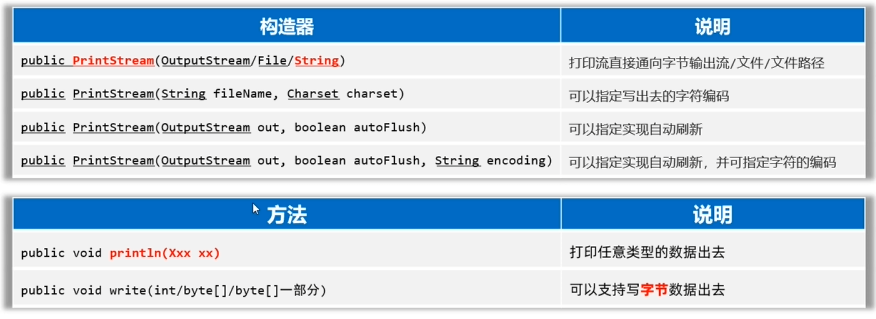
PrintWriter提供的打印数据的方案
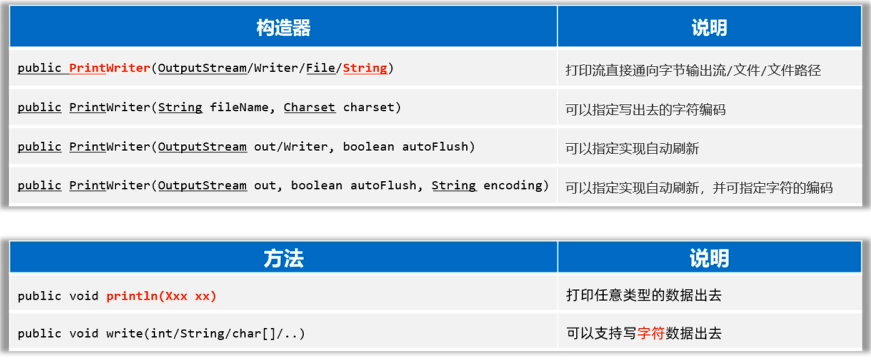
//目标:打印流,方便,高效的写数据出去
public class PrintStreamDemo01 {public static void main(String[] args) {try (PrintStream ps = new PrintStream("day10-io-code\\src\\ps.txt");
// PrintWriter pw = new PrintWriter("day10-io-code\\src\\ps.txt");//默认是覆盖PrintWriter pw = new PrintWriter(new FileWriter("day10-io-code\\src\\ps.txt",true));//追加){//写数据出去ps.println(97);ps.println("2314asdf");ps.println('A');ps.println(16.5);ps.println(true);ps.println("------------------------------------");pw.println(751);pw.println('a');pw.println("我是中国人,我爱我的祖国!");pw.println(true);} catch (Exception e) {e.printStackTrace();}}
}
PrintStream和PrintWriter的区别
- 打印数据的功能上是一模一样的:都是使用方便,性能高效(核心优势)
- PrintStream继承自字节输出流OutputStream,因此支持写字节数据的方法。
- PrintWriter继承自字符输出流Writer,因此支持写字符数据出去。
打印流的一种应用:输出语句的重定向。

案例
//目标:输出语句的重定向
public class PrintStreamDemo02 {public static void main(String[] args) throws FileNotFoundException {System.out.println("红豆生南国");System.out.println("春来发几枝");PrintStream ps = new PrintStream(new FileOutputStream("day10-io-code\\src\\ps.txt", true));System.setOut(ps); //把系统的打印流改成自己的打印流System.out.println("愿君多采撷");System.out.println("此物最相思");}
}
IO特殊数据流---数据输出流(DataOutputStream)
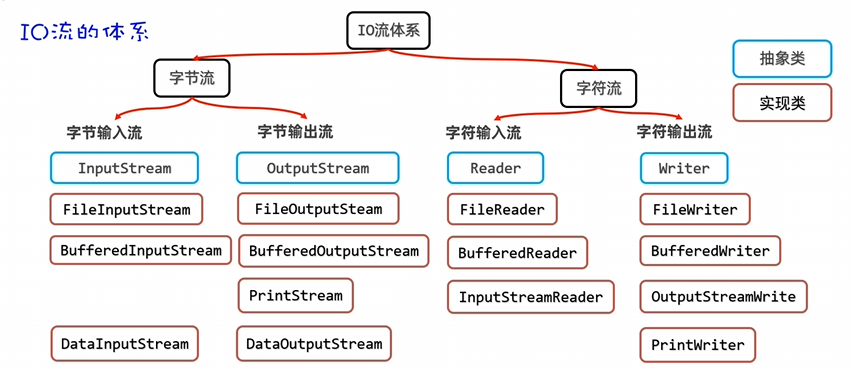
- 允许把数据和其类型一并写出去。
![image]()
案例
public class DataOutputStreamDemo02 {public static void main(String[] args) {try(DataOutputStream dos = new DataOutputStream(new FileOutputStream("day10-io-code\\src\\dos.txt"));){//写入数据dos.writeByte(97);dos.writeBoolean(true);dos.writeInt(4232);dos.writeChar('c');dos.writeChars("zcvsadf55");dos.writeUTF("我是中国人!");}catch (Exception e){e.printStackTrace();}}
}
DataInputStream(数据输入流)
- 用于读取数据输出流写出去的数据。
![image]()
案例
//特殊数据输入流
public class DataInputStreamDemo01 {public static void main(String[] args) {try(DataInputStream dis = new DataInputStream(new FileInputStream("day10-io-code\\src\\dos.txt"));){System.out.println(dis.readByte());System.out.println(dis.readBoolean());System.out.println(dis.readInt());System.out.println(dis.readChar());System.out.println(dis.readUTF());}catch (Exception e){e.printStackTrace();}}
}
注意:输出流和输入流的数据类型读写顺序必须保持一致,否则会报错。
IO流---序列化流
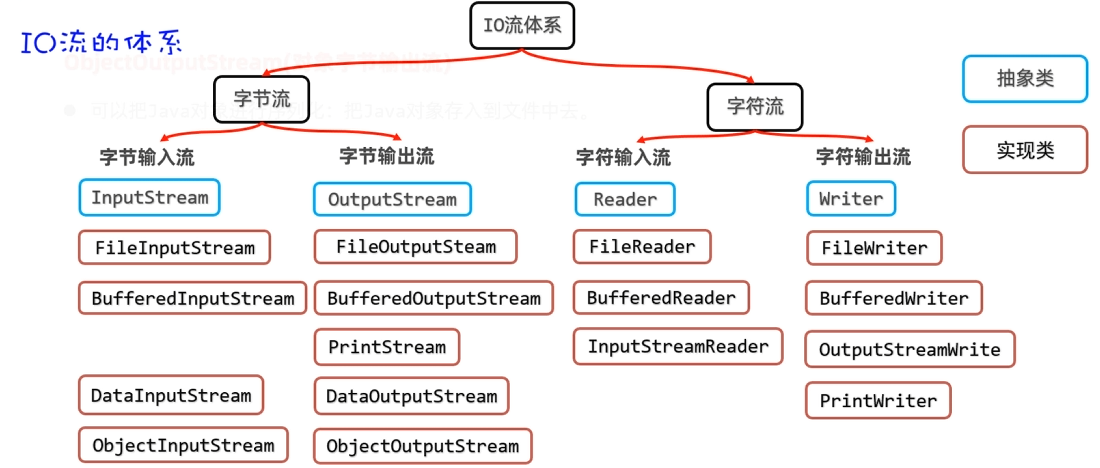
ObjectOutputStream(对象字节输出流)
- 对象序列化:把java对象写入到文件中去。
![image]()
注意:对象如果要参与序列化,必须实现序列化接口(java.io.Serializable)
案例
学生类:
@Data
@NoArgsConstructor
@AllArgsConstructor
//注意:如果学生对象要参与序列化,那么学生类必须实现Serializable接口,否则会抛出NotSerializableException异常。
public class Student implements Serializable {private String name;private int age;//transient:修饰的成员变量,不能参与序列化。private transient String password;private double height;
}测试类:
//目标:完成对象的序列化:把java对象存储到文件中去。
public class ObjectOutputStreamDemo01 {public static void main(String[] args) {//1.创建一个Student对象Student s1 = new Student("电驴", 18, "123456", 1.78);//2.创建对象字节输出流管道与目标文件接通try(ObjectOutputStream oos = new ObjectOutputStream(new FileOutputStream("day10-io-code\\src\\obj.txt"));){//3. 开始写对象出去oos.writeObject(s1);} catch (IOException e) {e.printStackTrace();}}
}
- 对象反序列化:把文件里的java对象读出来。
案例
//目标:完成对象的反序列化:把文件中的数据恢复成java对象。
public class ObjectInputStreamDemo02 {public static void main(String[] args) {Student s1;try (ObjectInputStream ois = new ObjectInputStream(new FileInputStream("day10-io-code\\src\\obj.txt"));){s1 = (Student) ois.readObject();System.out.println(s1);} catch (Exception e) {e.printStackTrace();}}
}
如果要一次序列多个对象,怎么办?
- 用一个ArrayList集合存储多个对象,然后直接对结合进行序列化即可。
- 注意:ArrayList集合已经实现了序列化接口。
IO框架
什么是框架?
- 解决某类问题,编写的一套类、接口等,可以理解成一个半成品,大多数框架都是第三方开发的。
- 好处:在框架的基础上开发,可以得到优秀的软件架构,并能提高开发效率。
- 框架的形式:一般是把类、接口等编译成class形式,再压缩成一个.jar结尾的文件发行出去。
![image]()
什么是IO框架?
- 封装了Java提供的对文件、数据进行操作的代码,对外提供了更简单的方式来对文件进行操作,对数据进行读写等。
commons-io-2.11.0.jar框架
导入commons-io-2.11.0.jar框架到项目中去。
- 在项目中创建一个文件夹:lib
- 将commons-io-2.6.jar文件复制到lib文件夹
- 在jar文件上点右键,选择Add as Library->点击OK
- 在类中导包使用
下载地址:https://commons.apache.org/io/download_io.cgi
- Commons-io是apache开源基金组织提供的一组有关IO操作的小框架,目的是提高IO流的开发效率。
![image]()
![image]()
案例
//目标:使用Commons IO框架进行IO操作
public class CommonsIODemo01 {public static void main(String[] args) throws IOException {FileUtils.copyFile(new File("day10-io-code\\src\\dos.txt"), new File("day10-io-code\\src\\dos1.txt"));
// FileUtils.copyDirectory(new File("D:\\java_project\\resource\\b"), new File("D:\\java_project\\resource\\b1"));
// FileUtils.deleteDirectory(new File("D:\\java_project\\resource\\b"));//JDK7开始也新增了单行复制相关的技术Files.copy(Path.of("day10-io-code\\src\\dos.txt"), Path.of("day10-io-code\\src\\dos2.txt"));}
}
案例:复制文件夹
//目标:复制文件夹
//源文件夹:D:\java_project\resource\
//目标文件夹:E:\
public class CopyDirectoryDemo01 {public static void main(String[] args) {try {copyDirectory(new File("D:\\java_project\\resource\\"), new File("E:\\"));} catch (Exception e) {e.printStackTrace();}}public static void copyDirectory(File srcDir, File destDir) throws Exception {//1.判断源文件夹是否存在if(srcDir == null || destDir == null || !srcDir.exists()|| !destDir.exists() || srcDir.isFile() || destDir.isFile()) {return;}//2.开始拷贝之前,先在目标位置创建新的文件夹名和原文件夹名称一样。File destNewDir = new File(destDir, srcDir.getName());destNewDir.mkdirs();//3. 提取原始目录的一级文件对象File[] files = srcDir.listFiles();//4. 判断这个目录是否可以拿到一级文件对象if(files == null || files.length==0) return;//5. 遍历全部一级文件对象,拷贝到新的目录中for (File file : files) {if(file.isFile()){FileUtils.copyFile(file, new File(destNewDir, file.getName()));}else {copyDirectory(file, destNewDir);}}}
}
案例:删除文件夹
//目标:删除文件夹
public class DeleteDirDemo02 {public static void main(String[] args) {deleteDirectory(new File("e:\\resource\\"));}public static void deleteDirectory(File dir){//1. 不删除的情况if(dir == null || !dir.exists()) return;//2. 如果是文件,直接删除if(dir.isFile()) {dir.delete();return;}//3.文件夹File[] files = dir.listFiles();if(files == null) return;if(files.length == 0){dir.delete();return;}//4.遍历全部一级文件对象,删除for (File file : files) {if(file.isFile()){file.delete();}else {deleteDirectory(file);}}//5.删除自己dir.delete();}
}
课外拓展案例:啤酒问题
- 需求:啤酒2元一瓶,4个盖子可以换一瓶,2个空瓶可以换一瓶,10元可以买多少瓶?剩余多少个盖子和空瓶?
代码
//目标:啤酒问题:啤酒2元一瓶,4个盖子可以换一瓶,2个空瓶可以换一瓶,10元可以买多少瓶?剩余多少个盖子和空瓶?
public class BeerDemo03 {public static int totalBeers;public static int lastBottles;public static int lastCovers;public static void main(String[] args) {buyBeers(10);System.out.println("一共可以买"+ totalBeers + "瓶酒,"+ "还剩" + lastBottles + "个空瓶子,还剩" + lastCovers + "个瓶盖子!");}public static void buyBeers(int money) {//1.拿钱买酒int beers = money /2;totalBeers += beers;//2.计算出本轮总共的空瓶和盖子数,换算成钱继续递归买酒。int totalBottles = lastBottles + beers;int totalCovers = lastCovers + beers;//3. 换算成钱,继续买酒int newMoney = 0;if(totalBottles >= 2){newMoney += (totalBottles / 2) * 2;}lastBottles = totalBottles % 2; //记录剩余瓶子数if(totalCovers >= 4){newMoney += (totalCovers / 4) * 2;}lastCovers = totalCovers % 4; //记录剩余盖子数if(newMoney >= 2){buyBeers(newMoney);//递归}}
}











